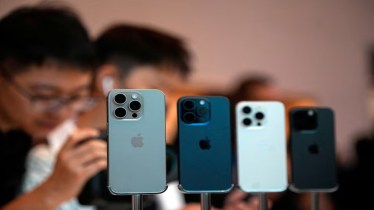Even as the premiumisation trend largely led by iPhones is driving the festive season sales, the overall smartphone market growth in volume terms is seen flat this time, analysts said.
The reason for stagnancy in volume growth can be attributed to less spending in the mass market segment below Rs 25,000, increase in smartphone holding cycle, structural demand issues, and competition from the refurbished smartphone market, among others, according to analysts.
The weakness in smartphone volumes is largely seen from the e-commerce companies, analysts said.
According to Counterpoint Research, in the first week of festive sales, the smartphone volumes fell 3% year-on-year (YoY) but the channel checks suggest that the same later improved with mainline (offline) retailers started giving bundled offerings and discounts.
“The value growth of 9-10% is seen in line. However, the volume growth could be flat. Earlier, we estimated the volume growth of about 3%,” said Tarun Pathak, research director at Counterpoint India. According to Pathak, a slower feature phone to smartphone conversion compared to previous year, also led to less uptake in volumes.
Going by last year’s festive season sales, the smartphone sales in volume grew 6%, while that in value terms grew 23%, according to Counterpoint data. Notably, more than 3 million iPhone units were sold during the festive season.
With regard to iPhone sales this time, the overall volume growth has been in single digits but value growth has been in double digits on the back of strong iPhone 15 series sales.
In the latest iPhone 16 series sales, pro models are being preferred more by aspirational consumers. Analysts said iPhone 15 series did perform better than the iPhone 16 series this festival season and compared to last festive season sales when iPhone 15 was launched.
Faisal Kawoosa, chief analyst at Techarc said, “India has always been the latest minus one market when it comes to iPhones. The trend we have observed is that the pro model of iPhone 15 is being preferred over iPhone 16 owing to no major difference in features and offerings”.
On the overall festive season sales, Kawoosa said, there has been no major upsides especially in volumes and the business is as usual with people going after premium phones led by iPhones.
A smartphone company executive said, “growth in iPhone sales does not mean the whole market is growing. The growth is because of higher average selling prices (ASPs), which are also expected to see pressures owing to less demand”.
According to IDC, in the April-June quarter, smartphone ASPs grew by 2.8% YoY, however, they declined QoQ by 5.6%, at $248 (around Rs 20,850).
Ranjit Babu, director, consumer electronics at Amazon India said, “this Diwali season, we witnessed a remarkable surge in customer demand across our consumer electronics and appliances categories, particularly in the premium segment”.
According to Babu, within the smartphone category, the premium segment (priced above Rs 30,000) was the highest performer, experiencing a 30% YoY growth. The tablet category also registered exceptional performance, with 60% of sales coming from the premium segment, he said.
Mainline retailers, who witnessed aggressive sales, especially after the conclusion of e-commerce flagship sales, are looking to close the season with a 25-35% growth in smartphone value this time. In volume terms, they expect a 10-15% growth.
“This surge is driven by consumer trust in local retailers, consumer offers, bank cashbacks, and enticing lucky draw offers from brands such as Vivo, Oppo, Xiaomi, and Realme,” said Kailash Lakhyani, founder and chairman of All India Mobile Retailers Association (AIMRA).
“Furthermore, major OEMs like Samsung, OnePlus, and even Apple are ensuring ample stock to meet the growing demand. Financial solutions from NBFCs such as Bajaj Finserv, TVS Credit, and IDFC have also enhanced their services, providing quicker loan disbursements and consumer offers,” Lakhyani added.
Of the overall smartphone market, mainline constitutes about 50-52%% of the share. Analysts said people in the country have not left their preference for purchasing from retail stores owing to matched prices and option to try out features.
“During Covid, we saw a surge in online channels. However, smartphone brands have improved their presence equally in the offline space lately. Better trade-ins, variety of EMI options, and sales support are among the factors that are contributing to higher smartphone sales in offline stores,” said Shilpi Jain, senior analyst at Counterpoint Research.
According to Canalys, in the July-September quarter, India’s smartphone market grew 9% in volumes as companies focused on clearing inventories through online and offline channels. Vivo led the market with a 19% share, shipping 9.1 million units, during the quarter.
An analysis by Techarc suggests that in the online channels brands such as Apple, Realme, Motorola, Samsung, Vivo, Oppo, and One Plus offered a 5-18% discounts during the festive season sales.
